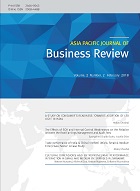
- P-ISSN2466-0043
- E-ISSN2508-4488
- Frequency By-annually
- PublisherAsia Pacific Journal of Business Review
- Indexed by
You can use ACOMS+ service with an AccessON integrated member account.
※ If you are already an AccessON integrated member, go back to the journal’s website and login.
